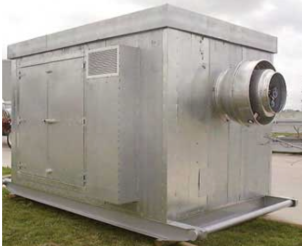In the third and final part of this series, I am going to discuss how blower enclosures can be used for silencing noisy blowers.
Enclosure Applications
Sometimes silencers aren’t enough to silence a really noisy PD blower. An enclosure built around a PD blower provides additional noise attenuation if either the noise from the silencers or noise from vibration and mechanical sources exceeds the desired limit. The addition of the enclosure works by absorbing the high frequency noise and deflecting the lower frequency noise. However, don’t make the mistake and think that an enclosure by itself can provide sufficient noise attenuation to eliminate the need for silencers on the inlet and outlet.
Enclosure Types
A properly sized and constructed standard full enclosure can provide an additional 20 dBA of noise attenuation. However, using a full enclosure does have some drawbacks. PD blowers generate a significant amount of heat, therefore using a full enclosure  will require an exhaust fan to remove this heat so that the PD blower isn’t damaged. Also, the air inlet for the PD blower will need to be piped to the outside of the full enclosure or if the PD blower is used to pull a vacuum, the outlet will need to be piped to the outside. For smaller PD blowers, a design trick for using a full enclosure is to locate the intake at the opposite end so that the air is pulled across the PD blower eliminating the need for an exhaust fan.
will require an exhaust fan to remove this heat so that the PD blower isn’t damaged. Also, the air inlet for the PD blower will need to be piped to the outside of the full enclosure or if the PD blower is used to pull a vacuum, the outlet will need to be piped to the outside. For smaller PD blowers, a design trick for using a full enclosure is to locate the intake at the opposite end so that the air is pulled across the PD blower eliminating the need for an exhaust fan.
A partial enclosure has four acoustically lined walls, but no top. To be effective, the height of the partial enclosure walls should be twice the distance measured from the floor to the center line of the PD blower. The main benefits of a partial enclosure is that it is simpler to design and cheaper to install than a full enclosure. However, there is one big drawback to a partial enclosure. Being that the partial enclosure has no top, anyone that has a direct line of sight to the PD blower will not benefit from the noise reduction.
Enclosure Design
There are four main criteria for designing an enclosure to achieve the desired noise attenuation:
- Size: While it seems obvious that the height, length and width are critical, these measurements must include the inlet and outlet silencers, access space for maintenance and room for an exhaust fan, if required.
- Access: PD blowers require periodic maintenance. To accommodate, the enclosure should have doors or removable panels to provide access for maintenance personnel. It is also very important that theses access doors or panels have proper seals to prevent sound leakage.
- Heat: Reduction of heat can be achieved with removal by the blower intake or by an exhaust fan. The amount of heat rejected by the PD blower will determine which heat removal method is best.
- Penetrations: The number and location of required penetrations, such as air inlet & outlet or electrical, should be determined. These too must have proper seals to prevent sound leakage.
Conclusion
There are a number of enclosure manufactures that can take your information and design an enclosure for your application, but will it be the best solution for your problem? Eldridge has represented McGill AirSilence in the Texas market for many years. This long standing partnership has allowed Eldridge to provide our customers with the highest quality and most effective enclosures for noisy PD blowers.
We hope that you have enjoyed this three-part series on Silencing Noisy Blowers and learned the most effective solutions to this problem. If you have a noisy PD blower that is causing a problem for your employees, Eldridge is here to help. Let us come out to your location, survey the problem and recommend a solution that will create a quieter working environment for your team.
